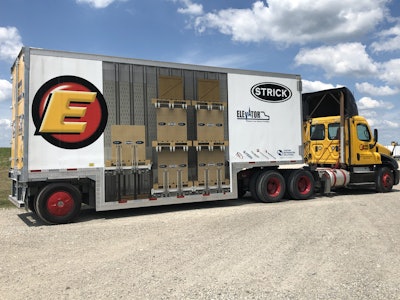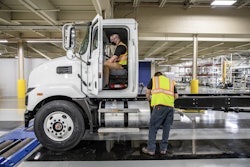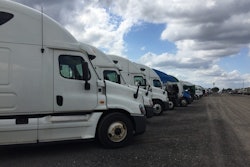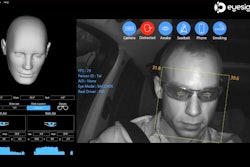 Nate Wells, senior vice president of linehaul at XPO Logistics, called track-and-trace technology “one of most critical linchpins in the LTL business.”
Nate Wells, senior vice president of linehaul at XPO Logistics, called track-and-trace technology “one of most critical linchpins in the LTL business.”“We do two things in LTL,” said Nate Wells, senior vice president of operations planning and engineering for XPO Logistics (CCJ Top 250, No. 6). “We sell space and pace.”
Neither of these actions is easy, as explained by Wells and less-than-truckload (LTL) fleet executives from Saia, AAA Cooper, Estes Express and YRC Worldwide during a video call on Tuesday hosted by Optym, a developer of cloud-based transportation management software (TMS) for truckload and LTL carriers.
LTL operations are more complex than truckload since each shipment has to pass through at least two or three locations before reaching the end customer, Wells said. To sell space on a trailer, LTL carriers need accurate information about shipment volume, dimensions and transit times.
Carriers also have a complex planning process for their pickup-and-delivery (P&D) and linehaul routes. Route planning, especially for linehaul, is the biggest opportunity for cost savings, the executives said.
XPO Logistics’ linehaul division runs 2.6 million miles daily and is the carrier’s largest operational spend. “We want to ensure when we are driving that we are doing it in the most meaningful, efficient way [possible],” Wells said.
Getting shipments into trailers efficiently is where XPO Logistics excels with a proprietary application it uses for handhelds. Dock workers scan every shipment and management has real-time visibility for every associate’s daily activities. They receive an alert if a worker has not scanned a pallet in 30 minutes.
The company uses the activity data to create a friendly competition among dock workers. Wells attributes the technology to dock efficiency improvements of between 5% and 20% across its terminal network.
Overall, XPO Logistics has seen its operating ratio (OR) improve during 16 of the last 19 quarters, said Wells, who believes that LTL carriers can further improve operational costs by 3% to 5% using optimization software for planning and executing P&D and linehaul routes.
“To be in this conversation for the next 16 quarters, we are going to have to embrace technology by increasing our stops per route and decrease miles per route,” he said, noting that optimization software is the next step. “We want to press the easy button.”
Webb Estes, vice president of process improvement for Estes Express (No .12), agreed that optimizing linehaul is one of the biggest opportunities for LTL carriers. The Richmond, Virginia-based company runs more than 500 million miles per year.
 CCJ recently covered a new trailer innovation by Estes Express that enables the carrier to increase capacity for pickup and delivery routes. Click the image to learn more.
CCJ recently covered a new trailer innovation by Estes Express that enables the carrier to increase capacity for pickup and delivery routes. Click the image to learn more.LTL carriers also have to meet customers’ shipment visibility expectations. Wells called track-and-trace technology “one of most critical linchpins in the business.”
Charlie Prickett, chief operating officer for AAA Cooper Transportation (No. 49), said the Dothan, Alabama-based company’s proprietary technology gives customers continuous visibility and real-time ETAs from pickup to delivery, which are accurate within three to five minutes of arrival.
To enhance this visibility, AAA Cooper is adding pre-pickup visibility for customers to view the status of the pickup driver to plan labor on their own docks, Prickett said.
For next-level visibility, Wells is eyeing the potential of using RFID labels on pallets to have internal and customer visibility of freight. Using RFID would require the company to install antennas and other equipment in facilities.
Another option is low-energy Bluetooth tags, which can locate pallets in facilities and during transit. Wells said enhanced shipment visibility can be sold as a service to customers by tagging their freight with RFID or Bluetooth devices at pickup.
Wells and other fleet executives on the call also spoke about the need to use more dimensioning technology for shipments to have better data for pricing and for capacity planning.
“We need to embrace this,” he said of dimensioning technology, since the traditional pricing model for LTL is based on rate tariffs that make it more difficult for customers.
Ravi Ahuja, Optym’s founder and chairman, said one of focus points for LTL carriers is to get an electronic bill of lading from shippers before a driver arrives for a pickup to know the shipment’s attributes in advance for capacity planning from P&D through linehaul.
Ahuja also said that carriers still using AS400 or “green screen” mainframe systems are at a disadvantage, because the platforms are more difficult to support data science initiatives and software integration.
He believes that LTL carriers have an opportunity to reduce their P&D costs by up to 5% by using optimization software that calculates routes dynamically by taking into account real-time traffic and road conditions.
Optimization software also can help centralize dispatch to reduce manpower and improve quality of service, Ahuja said. Another area of opportunity is to use software for assigning trailers to dock locations – based on predicted arrivals, departures and workload – to decrease the time it takes to load and unload freight, he said.











